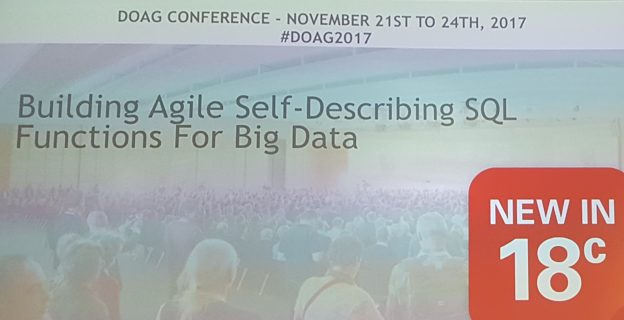Hey, Oracle 18c is now available on the cloud and for engineered systems! For more than a week now. That also means you can play with it at LiveSQL. And of course you can try polymorphic table functions (PTF)! At least I’ve done that this weekend 😉 And here is my first working example. Continue reading
Category Archives: SQL

Polymorphic Table Functions
Last month I attended the DOAG conference in Nuremberg. As always, it was a great event, awesome community and excellent tech talks. And it seems that I’ve found what could be my favorite feature in the upcoming database release 18c. Keith Laker (@ASQLBarista), Oracle’s Product Manager for Analytic SQL, talked about “Building Agile Self-Describing SQL Functions For Big Data”. This title was promising enough for me and of course I wasn’t disappointed. Thanks a lot for an interesting presentation!
This blog post will be somewhat unusual, because I have actually no knowledge to share yet, but only the euphoria about the power and flexibility of the new feature. So what is it about?
Continue readingDebugging SCD2
This post is again about the Slowly Changing Dimensions Type 2, but focusing on another problem. Once you have a need to validate the versioning mechanism, how you can do this? Or, in other words, having several versions of the same data (identified by the natural key), how to check what fields have been changed from version to version? Working with systems like Siebel CRM, which have some tables with 500+ columns, this possibility was really useful.
Of course you can write some PL/SQL code and iterate through the columns to compare their values. But I’m a friend of “pure SQL” solutions – let’s see how this can be done. Continue reading
Data Historization II
In the previous post I have shown how to use a combination of a UNION ALL and a GROUP BY to do a slowly changing dimension type 2 data historization. I’ve done some tests since then to compare performance of this approach with common methods in various situations. Continue reading
How to simplify the data historization?
Maintaining a data historization is a very common but time consuming task in a data warehouse environment. You face it while loading historized Core-Layer (also known as Enterprise Data Warehouse or Foundation Layer), Data Vault Models, Slowly Changing Dimensions, etc. The common techniques used involve outer joins and some kind of change detection. This change detection must be done with respect of Null-values and is possibly the most trickiest part. A very good overview by Dani Schnider can be found in his blog: Delta Detection in Oracle SQL
But, on the other hand, SQL offers standard functionality with exactly desired behaviour: Group By or Partitioning with analytic functions. Can it be used for this task? Does it make sense? And how would the ETL process look like? Can we further speed up the task using partition exchange and when does it make sense? I’ll look at this in the next few posts. Continue reading
MERGE and ORA-30926 – Part 2 or differences in write consistency between update and merge
In the first part we’ve seen how Oracle actually executes the Merge Statement three times if it hits ORA-30926. To understand what’s going on, we should refresh the concept behind so called “update restarts” sometimes also called “mini rollbacks”. This concept is very well explained by Tom Kyte: Part I, Part II and Part III. If you are not familiar with this “write consistency” concept, I strongly encourage you to follow this links. Continue reading
MERGE and ORA-30926
If you’ve ever used MERGE, then it is quite probable that you are familiar with ORA-30926 – unable to get a stable set of rows in the source tables. You have also probably noticed, that in case of hitting this error, your query takes longer. Three times longer, because the whole query is executed three times, as following tests show.
Continue readingMerging temporal intervals using MATCH_RECOGNIZE
Some time ago Philipp Salvisberg has posted several thoughts about joining and merging temporal intervals. Recently I was looking for some examples of using the new MATCH_RECOGNIZE clause introduced in 12c and found that these queries can be significantly simplified using the new clause.
Continue reading
Null Accepting Semi-Joins in 12c
One of the new query optimizations in 12c are the null-accepting semi-joins. They make subquery unnesting and a semi-join possible in a situation which led to FILTER operation in older versions. Continue reading
Subquery Unnesting – if it doesn’t work
Actually, the CBO usually does a good job optimizing “NOT IN” subqueries. Unless something goes wrong. Recently it took a long time on a 10.2.0.5 database to search for the reason. At last looking in the CBO trace files (event 10053) has given the right hint.
Continue reading
